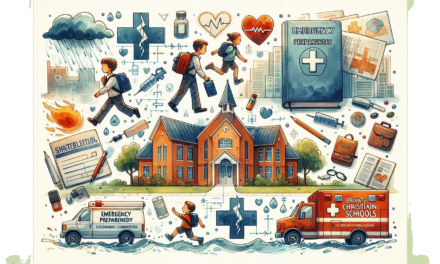In today’s rapidly evolving world, the importance of health education and promotion in schools cannot be overstated. School pediatricians, in collaboration with school nurses, play a pivotal role in developing and implementing comprehensive health education programs. These programs cover a wide range of topics, including nutrition, physical activity, substance abuse prevention, and sexual health. The American Academy of Pediatrics (AAP) strongly supports these initiatives, recognizing their potential to empower students to make informed decisions about their health.
The Role of School Pediatricians and Nurses
School pediatricians and nurses are at the forefront of health education in schools. Their collaboration is essential in creating effective programs that address the diverse health needs of students. By working together, they can ensure that health education is not only informative but also engaging and relevant to students’ lives.
Key Responsibilities:
- Assessment and Planning: School pediatricians and nurses assess the health needs of the student population and plan programs that address these needs. This involves collecting data on health behaviors, identifying risk factors, and setting goals for improvement.
- Implementation: Once the programs are planned, school pediatricians and nurses work together to implement them. This may involve classroom presentations, workshops, and interactive activities that engage students in learning about health.
- Evaluation: Continuous evaluation is crucial to ensure the effectiveness of health education programs. School pediatricians and nurses monitor the outcomes of these programs and make necessary adjustments to improve their impact.
Nutrition Education
Nutrition education is a fundamental component of health education programs. Proper nutrition is essential for students’ physical and cognitive development, and it plays a significant role in preventing chronic diseases.
Key Topics:
- Balanced Diet: Teaching students about the importance of a balanced diet that includes a variety of foods from all food groups. Emphasizing the benefits of fruits, vegetables, whole grains, lean proteins, and dairy products.
- Healthy Eating Habits: Encouraging students to develop healthy eating habits, such as eating regular meals, avoiding excessive sugar and processed foods, and staying hydrated.
- Reading Food Labels: Educating students on how to read and understand food labels, enabling them to make informed choices about the foods they consume.
Physical Activity Promotion
Physical activity is another critical aspect of health education. Regular physical activity is essential for maintaining a healthy weight, improving cardiovascular health, and enhancing mental well-being.
Key Topics:
- Benefits of Physical Activity: Highlighting the numerous benefits of regular physical activity, including improved fitness, reduced risk of chronic diseases, and enhanced mood and mental health.
- Types of Physical Activities: Introducing students to various types of physical activities, such as aerobic exercises, strength training, and flexibility exercises. Encouraging them to find activities they enjoy and can incorporate into their daily routines.
- Creating Active Environments: Promoting the creation of active environments in schools, such as safe playgrounds, sports facilities, and opportunities for physical activity during breaks and after school.
Substance Abuse Prevention
Substance abuse prevention is a critical component of health education programs. Educating students about the dangers of substance abuse and providing them with the skills to resist peer pressure is essential for their well-being.
Key Topics:
- Understanding Substance Abuse: Providing students with information about different types of substances, including alcohol, tobacco, and drugs. Explaining the short-term and long-term effects of substance abuse on physical and mental health.
- Risk Factors and Prevention: Identifying risk factors for substance abuse, such as peer pressure, stress, and low self-esteem. Teaching students strategies to resist peer pressure and make healthy choices.
- Support and Resources: Informing students about available support and resources for those struggling with substance abuse. Encouraging them to seek help from trusted adults, such as school counselors and healthcare professionals.
Sexual Health Education
Sexual health education is a vital part of comprehensive health education programs. Providing students with accurate information about sexual health helps them make informed decisions and promotes healthy relationships.
Key Topics:
- Human Development: Educating students about human development, including puberty, reproductive health, and the physical and emotional changes that occur during adolescence.
- Healthy Relationships: Teaching students about the importance of healthy relationships, including respect, consent, and communication. Encouraging them to develop positive relationship skills.
- Prevention of Sexually Transmitted Infections (STIs) and Pregnancy: Providing information about the prevention of STIs and unintended pregnancies. Discussing the importance of safe practices, such as using condoms and other forms of contraception.
Empowering Students to Make Informed Decisions
The ultimate goal of health education and promotion is to empower students to make informed decisions about their health. By providing them with the knowledge and skills they need, school pediatricians and nurses can help students develop healthy behaviors that will benefit them throughout their lives.
Strategies for Empowerment:
- Interactive Learning: Using interactive learning methods, such as group discussions, role-playing, and hands-on activities, to engage students and make learning about health fun and meaningful.
- Student Involvement: Involving students in the planning and implementation of health education programs. Encouraging them to take an active role in promoting health within their school community.
- Positive Reinforcement: Providing positive reinforcement and recognition for students who demonstrate healthy behaviors. Celebrating their achievements and encouraging them to continue making healthy choices.
Conclusion
Health education and promotion in schools are essential for fostering a healthier future for students. By collaborating with school nurses, school pediatricians can develop and implement comprehensive health education programs that cover crucial topics such as nutrition, physical activity, substance abuse prevention, and sexual health. The AAP’s support for these initiatives underscores their importance in empowering students to make informed decisions about their health. Through effective health education, we can equip students with the knowledge and skills they need to lead healthy, fulfilling lives.





